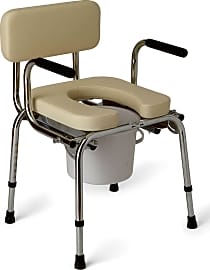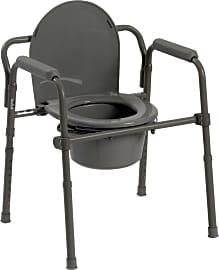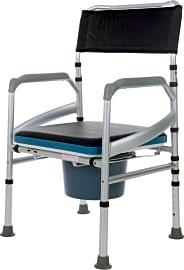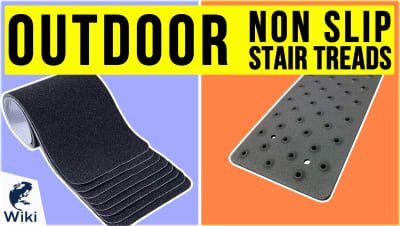The 9 Best Commodes

This wiki has been updated 34 times since it was first published in October of 2016. One of the most frustrating — and potentially embarrassing — problems with having limited mobility is the inability to go to the bathroom on one's own. These commodes allow users to access a toilet either by themselves or with minimal assistance from a caregiver or family member, and can help to provide an enhanced level of independence for those with injuries or chronic conditions. When users buy our independently chosen editorial picks, we may earn commissions to help fund the Wiki.
Editor's Notes
March 13, 2019:
Since the same individuals who need help using the toilet also often need support when taking a shower, we included the versatile Medline Elements and UltraCommode XL, both of which are approved for bathing and made of materials that won't rust when wet. When discretion is of the utmost importance, the Nova 8700-S, which comes apart quickly and packs down small enough to put in a closet, and again the Medline Elements, which looks like a regular chair, will be useful. There's no need to compromise on comfort when using the restroom, so we also added the well-padded Medline G98204, and the Sukong Portable, which has molded armrests and a backrest.
The Benefits Of A Commode Chair
These increasing adjustments might drive you to look up assisted living homes.
If you are caring for an elderly parent, first off, know that you are not alone — the number of baby boomers caring for their elderly relatives has increased dramatically in recent years due to the cost of in-home nurses. So, should you fall into this category, then you know about the delicate balancing act of ensuring your elderly loved one is safe and comfortable, while still feeling a sense of independence. At first, your relative might resist the idea of a commode because it indicates a transition into a new phase of life. They will eventually see, however, that this item will actually let them maintain a feeling of normalcy.
When someone's mobility decreases, doing something as simple as going to the bathroom and using the toilet becomes a tremendous task. Remember that commodes double as walkers, giving someone with reduced autonomy a safe way to get to the restroom. Without such a device, many bedridden individuals must call for help when they need to go to the bathroom, leaving them at the mercy of others. A commode allows them the freedom to get up and go, without the help of somebody else. While a regular walker would allow for the same thing, it would still leave the issue of how the individual would safely use a regular toilet once in the restroom, as these are generally too low, and can be dangerously slippery. A commode solves both of these problems, since it has an elevated toilet seat, and allows an elderly individual to maintain some privacy in bathroom matters.
As your relative becomes older, you'll regularly find changes you need to make to the home. These increasing adjustments might drive you to look up assisted living homes. Though you'll find that locating the price of these can be difficult, the figure you'll probably eventually land on is somewhere between $40,000 and $90,000 a year. While it would be nice to put your older family member in a place that is designed specifically for the needs of the elderly, many people just cannot afford that. A commode is a device that can help postpone larger renovations in the home (like making changes to the bathroom), while allowing the user to remain in the house that they know and love longer.
Tips For Using A Commode
Helping someone use a commode can be a bit uncomfortable for all parties at first, which is just one reason we should pay elderly care nurses more respect — they do it several times a day, with a smile on their face. Here are tips, however, that streamline the process. There are two ways a commode can be used: 1) the individual can either relieve himself directly into the container attached to the seat and 2) if the user can make it to the actual toilet, the bucket can be removed, the commode seat can go directly over the regular toilet, and the individual can use the restroom as usual. Depending on the individual's mobility or sense of urgency, they may choose either method at various times.
Even though men are used to standing while handling certain business, it's best that elderly males always sit on the commode to keep their balance.
Regardless of which way the person uses it, it's important to safely get them from the bed and either standing to walk the commode to the bathroom, or sitting to use it right there. In order to do that, ask them to sit on the side of the bed and lean forward, pushing their arms against the side of the bed. From there, you can hook each of your arms beneath theirs and help them up. If they will use the commode there, make sure its wheels are locked. Help the individual turn around slowly before sitting down, and ensure the users legs are not crossed when they sit. Even though men are used to standing while handling certain business, it's best that elderly males always sit on the commode to keep their balance.
Naturally, if the person does make use of the attached bucket, there will be some cleaning involved. There are a few things you should gather in advance, including a disinfectant, disposable gloves, a toilet bowl scrub, and adult wipes. Put a bit of warm water inside the bucket before the person uses it, as this will make cleaning it easier. After the user is finished, help him or her wipe themselves if needed. Once you've returned the person safely to bed, you will take the bucket to the toilet, empty its contents, scrub it out, and re-attach it to the commode seat.
Other Ways To Make Your Home Safer For Seniors
In addition to adding a commode, there are some changes you can make around your home to make it safer for your elderly relative. Slippery surfaces are very dangerous for aging individuals since their weaker bones make them more prone to falls. Add runners to hardwood and tile floors, and staple these down so that the wheels of a walker do not get stuck on them. Non-skid mats in the bathroom are also important. You can make stairways more secure, too, by adding non-slip treads to steps and rails.
When it comes to the kitchen, there are several things you can do that will allow your older relative to still cook, without coming in harm's way.
Good lighting is also important, since your senior citizen family member may not have as good of vision as they used to. Consider putting battery-powered lights around stairways to increase visibility. You can also install motion sensor lights around your home, so your family member doesn't need to go searching for a switch when they use the restroom in the middle of the night or walk down a hallway.
When it comes to the kitchen, there are several things you can do that will allow your older relative to still cook, without coming in harm's way. Make sure regularly used items like pots, pans, and coffee mugs are at eye level, so your senior family member never has to reach high shelves. Small buttons on appliances can be hard for seniors to see, so either switch to new models with larger, brighter controls or put highly visible labels on these. If you make the right changes, your family member can navigate your home safely and swiftly.














